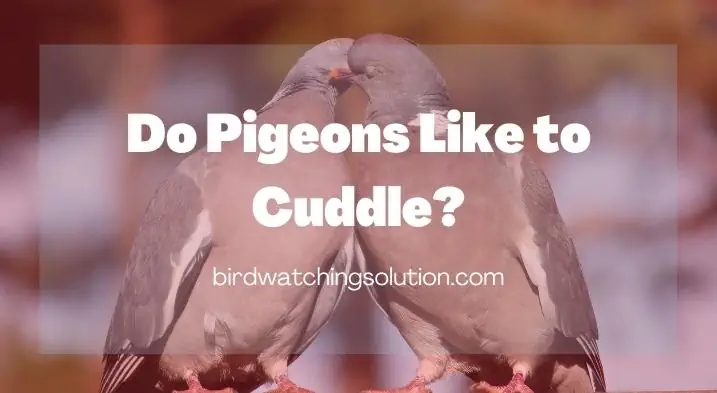How to Tell If a Bird Is Stunned or Dead
You just came out and saw a beautiful bird in your yard. It is not moving and you are getting a little worried about how to tell if a bird is stunned or dead?
The best way to know if a bird is stunned or dead is from its breathing condition. Approach the bird and gently pick it up and check for signs of low breathing or heartbeat. If you can’t feel the heartbeat then it is probably dead.
In this article, you will find complete information about such kinds of situations.
After reading this guide you will be able to easily tell the difference between a stunned or shocked bird and a dead bird.
I’ve also explained the best practices to follow in each situation so make sure you check it out before leaving.
How do I tell if a bird is alive?

If you are not sure if the bird is dead or stunned, then there are some easy ways to check whether it is alive. Here they are:
Check for breathing; breathe against their feathers and watch for movement (this will also tell you if they’re male or female) Put an ear against their chest and listen for heartbeats.
If you can’t find a heartbeat quickly, then the bird is probably dead. Check for twitching of its feet and legs; live birds will sometimes twitch as they begin to recover from the shock.
Wear gloves before you attempt to handle them as this will protect yourself from getting scratched or bitten if the bird gets frightened or tries to peck.
If a bird is not moving and you have already tried the steps above then it is probably dead, but this is very unlikely if you follow these simple steps.
Watch for eye blinking; birds blink their eyes even when they’re stunned so unless there’s a huge amount of trauma to its eyes or face, birds should be able to blink.
Check the body temperature; a bird’s normal body temperature is between 102 and 109 degrees Fahrenheit, but it will drop if they are in shock or dead.
However, there are some exceptions to this rule since the birds from a cold climate may have a slightly lower body temperature but is still warm enough for you to tell that they’re alive.
You can also check for feather fluffing if the bird is in shock or stunned, but don’t expect it to happen unless there’s something seriously wrong with them.
An easy way to tell if a bird is dead:
There are some common signs of a dead bird you need to look out for before assuming that it’s dead:
Check for stiff legs and feet; the muscles of a live bird will be relaxed while those of a dead one are stiff.
Also, check its eyes since they may be closed in cases where the bird dies from head trauma.
If you find no movement at all then it is probably dead unless you have found an exception to one of the rules above.
How do you know if a bird is in shock?
The signs of a shocked or stunned bird are feathers that are lying flat or sideways. Also, their head may tilt to one side and they may be dropping on the other side, but their eyes should be open.
Some of the signs of a dead bird include feathers that are clinging together, a frozen stiff pose with a raised neck, and their eyes closed. The dead birds are not able to grip because their muscles are stiff.
What Causes the Birds to be Stunned or Shocked?
There are many reasons that can shock or stun a bird, but by far the most common ones are collisions with man-made objects. Most often birds are stunned due to window collisions.
However, in worst cases, collisions with power lines can cause serious injuries or even result in the death of birds.
However, sometimes if a bird has sustained injuries due to a predator attack then there’s a high chance that it will be stunned or shocked.
Collisions with buildings; this usually happens to birds like pigeons and seagulls since they land on building ledges and roofs, but any bird can become shocked if it hits a building at high speeds.
Collisions with large windows and doors are also common and the pressure from the impact is usually enough to stun or shock a bird.
How do I Find Out If a Baby Bird is in Shock?
There are no ways for you to know if a baby bird has been shocked unless it’s fully grown. It is vital that you read the signs of a stunned or shocked adult bird since they will most likely affect the chicks as well.
Birds use their legs to grip onto surfaces while they are perching, but when they are in shock or stunned, they will not be able to do that. Also, babies birds should always be with their parents if you find them; there is a chance that the adults will abandon them because of your presence if you try to handle them.
How Do I Treat Stunned or Shocked Birds?
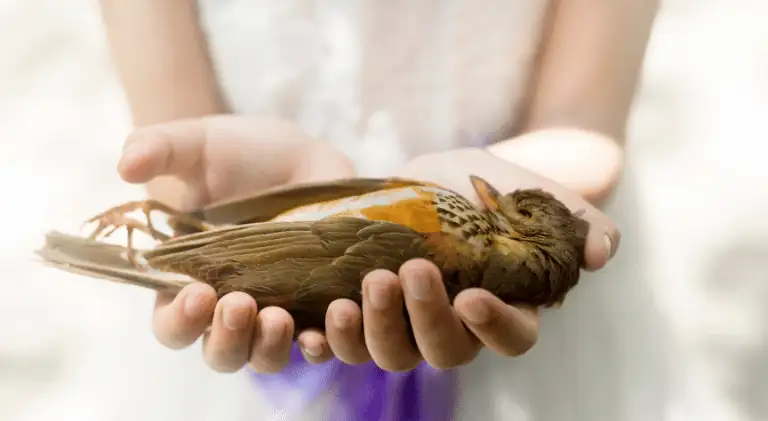
Stunned birds can be dangerous to handle since they might bite or scratch you, but there are ways that you can reduce the risk of being bitten or scratched by a bird.
Wear thick gloves if possible and cover their eyes with your hand for extra caution.
Hold them in a way that you are not facing them since they most likely will turn to face you.
However, if the bird is trying to peck or bite, turn it around so its back is facing you and cover its eyes again.
Keep the bird somewhere warm where no humans or pets can get access to it since they will most likely attack the bird if they get a chance.
Place the stunned and shocked birds in a cardboard box and keep it on a covered heating pad (low setting) or under an electric blanket for about 25 minutes before trying to release them into open spaces again.
They should be back to normal after that time period, but if they are not then you should contact a wildlife rehabilitator immediately.
It is vital that you do everything in your power to release the bird back into the wild as soon as possible since they are more likely to succumb to their injuries if you keep them for too long.
What to Do If You Find Birds That Are Stunned or Shocked Near Power Lines?
If you find a bird near power lines then it is very likely that they have been hit by those lines which can be fatal for birds.
In fact, even if the bird recovers from being stunned or shocked it will most likely not survive since predators will spot them easily when they are unable to fly properly.
It is vital that you contact a wildlife rehabilitator immediately and ask them to take the wild birds in for treatment.
What If I Find a Bird That Is Stunned or Shocked?
If you find a stunned or shocked bird, contact a local wildlife rehabilitator as soon as possible and let them know about your finding so they can go and collect the bird from where it is.
Do not attempt to handle the bird since newborns will most likely die if their parents abandon them and adult birds can cause a lot of damage with a single attack.
If you cannot get in touch with a wildlife rehabilitator then put the bird into a cardboard box and cover their eyes before putting them under an electric blanket or heating pad for about 25 minutes.
What not to do
If you come across a stunned or shocked bird,
- Do not attempt to pick up the bird and take them home since this will only increase their stress levels and make them more likely to abandon their young.
- Do not feed the baby birds, but leave food nearby if you see an adult feeding it.
- Do not take the babies away from where you found them since they are likely to be abandoned.
- Do not handle the birds if possible, but try to keep predators away from them instead.
What happens when a bird hits a window?
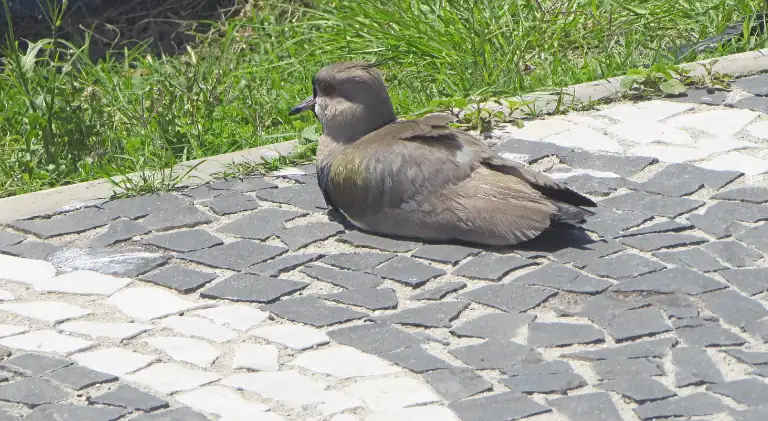
When a bird hits a window it most likely will be stunned or shocked for a few moments, but it can recover quickly after that.
However, they might have injured their head which can lead to internal bleeding so you should monitor the bird closely if possible.
If the bird is bleeding from its mouth then there are serious internal injuries since this means the trachea has been punctured.
You will need to contact a wildlife rehabilitator immediately since the bird might not be able to recover from its internal injuries in time for it to survive in the wild.
Can Stunned Birds Breathe?
Birds do rely on the wind to help them breathe, but if they are too stunned or shocked then it can be very difficult for them to breathe.
However, all birds need to breathe in order to survive. The longer a bird is too stunned or shocked, the more likely it will die since predators might attack it while it is unable to fly.
You should contact professionals to take the bird away so they can get it treated and release it back into its natural habitat once they are able to survive on their own again.
Examine the Bird and Look for Signs of Injury
Whenever you find a shocked bird on the ground the very first thing you need to do is to observe the bird carefully for injuries.
If the bird has a broken wing or a broken leg then you should contact a wildlife service since they will need medical attention to survive in the wild.
You shouldn’t leave the bird alone in all cases because sometimes due to wing injury it will not be able to fly and easily become prey of cats or other animals.
Prepare a Safe Shelter for the Birds
Next up, you need to prepare a safe shelter and keep the bird in it until it is fully recovered. You can make a decent shelter from a small box of cardboard.
Make sure to place a paper towel inside so that the bird feels comfortable inside. If the bird is an adult be sure to put some bird food inside the box too.
Try not to put water inside the cardboard box because it can easily be spilled and as a result make the situation worse.
Let the Bird Rest and Recover
The length of time a wounded bird needs to recover is based on how hurt it is and how long the injury has been. The bird should be recovering for 10 to 3 hours. If it’s been over four hours and the bird hasn’t come back, call a wildlife expert.
Covering the box with a bag means that fewer things will disturb it while it’s still scared. Don’t keep opening the box every few minutes to check on your bird because human presence can also scare them more.
If you haven’t looked at your bird in over four hours and they haven’t come back, call a wildlife specialist right away so they can help you.
Release the Bird
Once the bird has fully recovered, you should check if it is able to survive on its own before releasing it.
If the bird has an injured wing, you can keep it safe in a big cage for some time so that it can recover fully. Even after the wing injuries heal, the bird might not be capable of surviving in the wild.
You should release it as soon as it is fully recovered in order to prevent the bird from becoming too reliant on humans for survival.
How long do birds stay in shock?
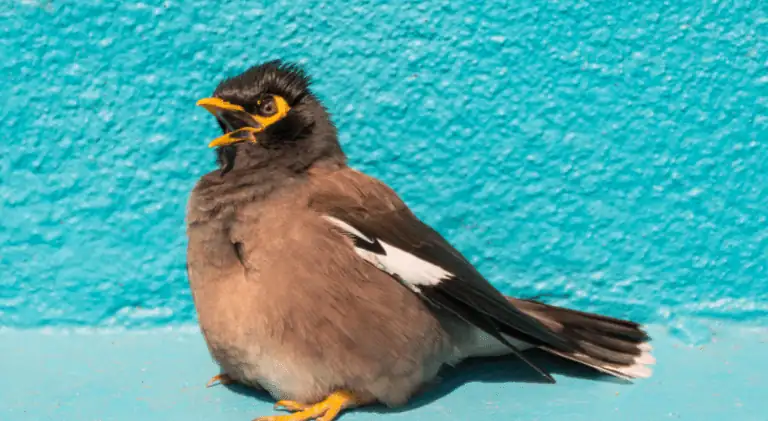
There is no agreed-upon time frame for birds to recuperate from shock, as each impact is different. It might take several hours for a bird to recover after significant impacts.
However, it is possible that only one minute is required. At this point, keep the birds away from stimuli while they heal so they can rest.
What to do if the bird is dead?
Unfortunately, if the little fellow is dead then you will need to call a wildlife rehabber to find out whether they can take it for a necropsy (animal autopsy).
In most cases, they will do this free of charge.
Dealing with Carcass
After the bird’s death, some people like to wrap it in a bag or bury it. Burying is an option. But make sure that the ground is not trashy and animals such as raccoons don’t dig up your body.
Always make sure to dig a bit deeper hole so that other wild animals cannot dig it up again and eat it.
Last Minute Thoughts
So how to tell if a bird is stunned or dead? Well, there are actually a few methods that can help you find out whether the bird is dead or it is just stunned. You need to look for the basic signs such as the movement of the bird etc.
Next, you need to approach it carefully and try to pick it up and see if its heart is beating or not. Moreover, if the bird is already dead, it may not be able to hold its head due to the muscle’s failure. However, if the birdie is just stunned or injured or shocked then you must take it to shelter and try to help it.
The best thing to help the bird is to keep it safe from pets and humans and let wildlife professionals know if you have such a situation.
I hope you’ve enjoyed reading this article, for more interesting guides related to birds and overall birdwatching feel free to visit my site and check out the other articles too.

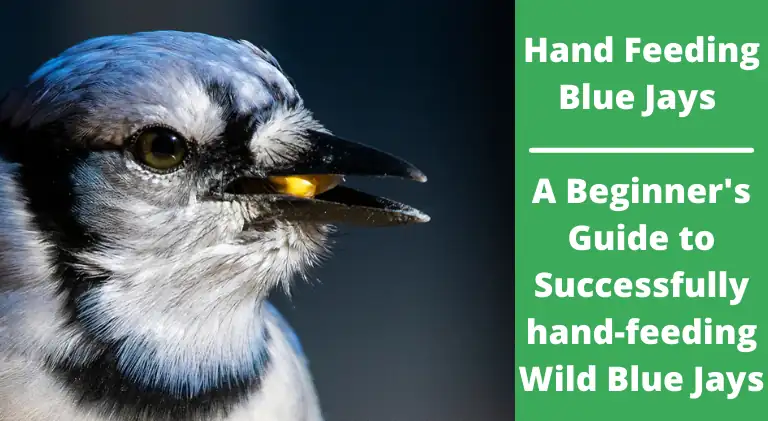

![Why Are Owls Considered Wise? – [Shocking Experimental Facts]](https://birdwatchingsolution.com/wp-content/uploads/2022/06/Why-Are-Owls-Considered-Wise_.webp)


